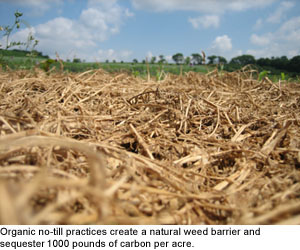29
Jun
U.S. Court Upholds Ban on Genetically Engineered Alfalfa – Again
(Beyond Pesticides, June 29, 2009) Last week the United States Court of Appeals for the Ninth Circuit re-affirmed its previous decision upholding a nationwide ban on the planting of genetically-engineered (GE) Roundup Ready alfalfa pending a full Environmental Impact Statement (EIS). The Court determined that the planting of genetically modified alfalfa can result in potentially irreversible harm to organic and conventional varieties of crops, damage to the environment, and economic harm to farmers.
Although the suit was brought against the United States Department of Agriculture (USDA), Monsanto Company and Forage Genetics entered into the suit as Defendant-Intervenors. In September 2008 the Ninth Circuit affirmed the lower court’s ruling, but the Intervenors continued to press the appeal alone, requesting the appellate court to rehear the case. Last weeks decision denied that request and re-affirmed the earlier decision in full.
“This ruling affirms a major victory for consumers, ranchers, organic farmers, and most conventional farmers across the country,” said Andrew Kimbrell, Executive Director of the Center for Food Safety. “Roundup Ready Alfalfa represents a very real threat to farmers’ livelihoods and the environment; the court rightly dismissed Monsanto’s claims that their bottom line should come before the rights of the public and America’s farmers. This ruling is a turning point in the regulation of biotech crops in this country.”
Today’s decision again upholds District Court Judge Charles Breyer’s earlier ruling of May 2007, in which he found that the USDA failed to address concerns that Roundup Ready alfalfa will contaminate conventional and organic alfalfa. The Ninth Circuit decision affirms that USDA violated national environmental laws by approving GE alfalfa without a full EIS.
In response to a government report that cited problems with the USDA’s oversight of GE crops, the Center for Food Safety along with co-plaintiff’s Beyond Pesticides, Western Organization of Resource Councils, National Family Farm Coalition, Sierra Club, Cornucopia Institute, Dakota Resource Council, Trask Family Seeds, and Geertson Seed Farms, filed the lawsuit in 2006 calling the department’s approval of GE alfalfa a threat to farmers’ livelihoods and a risk to the environment. The suit contended that the USDA improperly allowed the commercial release of GE alfalfa, the first commercial release of a GE perennial crop, and failed to analyze the public health, environmental, and economic consequences of the release. It also asserted that the GE alfalfa will likely contaminate natural alfalfa and ultimately prevent farmers from producing natural, non-GE alfalfa for markets that demand it. The suit cites the concerns of farmers with export markets. Buyers in Japan and South Korea, America’s major alfalfa export customers, have strongly stated that concerns about genetic contamination. U.S. alfalfa exports total nearly $480 million per year, with about 75% of exports going to Japan, according to 2006 data.
The GE alfalfa is designed to tolerate high doses of glyphosate, the active ingredient in Monsanto’s Roundup herbicide. However, 83% of U.S. alfalfa is grown without any herbicides, and many experts note that GE alfalfa could lead to massive increases in herbicide use on alfalfa and more chemical pollution in the environment. A study of GE soy has already shown that farmers growing the GE variety use two to five times more herbicides than farmers who plant natural soy varieties.
Scientific findings link the advent of GE crops to weeds developing resistance to glyphosate, the active ingredient in the herbicide Roundup. In turn, this weed resistance has led to increased herbicide use and forced farmers to turn to more toxic herbicides. According to the suit, USDA failed to address the potential impacts of the increased use of Roundup on alfalfa and failed to address issues relating to cross-pollination of wild relatives of alfalfa.
Alfalfa is grown on over 21 million acres, and is worth $8 billion per year (not including the value of final products, such as dairy products), making it the country’s third most valuable and fourth most widely grown crop. Alfalfa is primarily used in feed for dairy cows and beef cattle, and it also greatly contributes to pork, lamb, sheep, and honey production. Consumers also eat alfalfa as sprouts in salads and other foods.
For more information on GE crops, see Beyond Pesticides’ GE Food Pages.











 Incidents with flea and tick products can involve the use of spot-on treatments, sprays, collars and shampoos. However, the majority of the incidents reported to EPA are related to flea and tick treatments with EPA-registered spot-on products. Spot-on products are generally sold in tubes or vials and are applied to one or more localized areas on the body of the pet, such as in between the shoulders or in a stripe along the back. This advisory pertains only to EPA-registered spot-on flea and tick products; these products have an EPA registration number on the label.
Incidents with flea and tick products can involve the use of spot-on treatments, sprays, collars and shampoos. However, the majority of the incidents reported to EPA are related to flea and tick treatments with EPA-registered spot-on products. Spot-on products are generally sold in tubes or vials and are applied to one or more localized areas on the body of the pet, such as in between the shoulders or in a stripe along the back. This advisory pertains only to EPA-registered spot-on flea and tick products; these products have an EPA registration number on the label.

